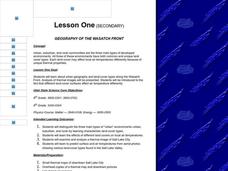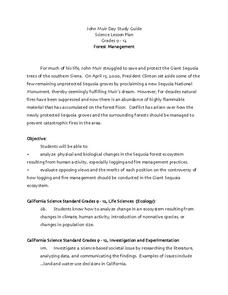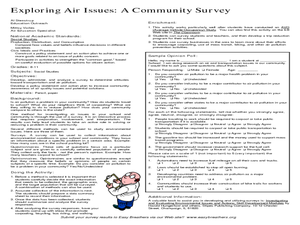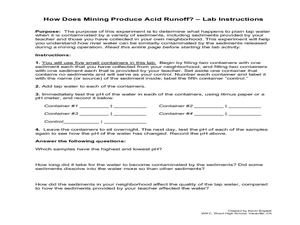Curated OER
Forest Management
Students analyze physical and biological changes in the Sequoia forest ecosystem, especially logging and fire management practices. They evaluate the controversy of how logging and fire management should be conducted in the Giant Sequoia...
Curated OER
Geography of the Wasatch Front
Students examine and discuss urban geography and land-cover types along the Wasatch Front. They analyze thermal images, create collages, and predict surface and air temperatures from aerial photos in the Salt Lake City Valley.
Curated OER
Geography of the Wasatch Front
Students identify the three main types of urban environments by learning characteristic land-cover types. They examine and analyze a thermal image of Salt Lake City. Then they predict surface and air temperatures from aerial photos.
Curated OER
Native Plant Restoration Project
Students distinguish between exotic and native plant species. They work in groups in the field to restore a natural habitat. A class map is created to reflect their work in the field.
Curated OER
Illegal Dumping
Students go on an outing and note garbage near picnic tables. They brainstorm ways to be involved with anti-litter campaigns and write letters to local officials.
Curated OER
Sonoran Desert
Students discuss the complicated environmental issues that face different people today. They establish legal positions surrounding several different scenarios.
Curated OER
Gridding a Site
Students make observations of effigy mounds and record them in a notebook. In groups, they must determine the scale of measurement and create their own grid to scale part of the Effigy Mounds National Monument. They also practice using...
Curated OER
Where are the Watersheds in San Francisco?
Students create a mental map of San Francisco. They compare it with actual topographical maps of the city. Then they label various locations on the San Francisco Hillshade map and locate watershed boundaries.
Curated OER
The Same But Different
Fourth graders observe different types of bats. They look for characteristics that appear to be fundamental for survival. Students observe population numbers in order to identify if adaptations aid in survival.
Curated OER
"Go Batty"
Students make a bat from a paper tube. They suspend bats from the ceiling or create a "cave" from black construction paper on a bulletin board or wall. Have students help you! Tape or staple student made bats in the "cave" to stress to...
Curated OER
Forest Management
Students explore the changes in the Sequoia forest ecosystem. They evaluate reasons for the changes and discuss opposing views of human activity, logging and fire management practices. Students observe a video, describe the location of...
Curated OER
Explorit's Picnic Time Quiz
In this outdoor picnic instructional activity, students complete a six question multiple choice on-line interactive quiz about animal and insect encounters that are possible while on a picnic.
Curated OER
Exploring Air Issues
Young scholars collects survey data from their community on air pollution. In this environmental science instructional activity, students consider the opinion of the community on air pollution and create a plan to reduce it. Young...
Curated OER
How Does Mining Produce Acid Runoff?
Learners examine how mining and other industry operations can lead to acid runoff. In this mining lesson students study weathering and complete a lab on it.
Curated OER
Pea Brain! Explorations in Estimation
Students estimate how many peas fit in a container. In this science lesson, students calculate the weight of a pea and record it. They use this data to calculate how many peas fit in a human brain.
Other popular searches
- Alabama State Parks
- Illinois State Parks
- California State Parks
- Arkansas State Parks Website
- Arkansas State Parks
- Us State Parks
















